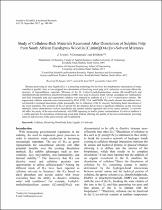 ResearchSpace
ResearchSpace
Study of Cellulose-Rich Materials Recovered After Dissolution of Sulphite Pulp from South African Eucalyptus Wood in [C2mim][OAc]/co-Solvent Mixtures
JavaScript is disabled for your browser. Some features of this site may not work without it.
- ResearchSpace
- →
- Research Publications/Outputs
- →
- Journal Articles
- →
- View Item
| dc.contributor.author |
Tywabi, Z

|
|
| dc.contributor.author |
Deenadayalu, N

|
|
| dc.contributor.author |
Sithole, Bishop B

|
|
| dc.date.accessioned | 2018-01-23T10:05:25Z | |
| dc.date.available | 2018-01-23T10:05:25Z | |
| dc.date.issued | 2017-09 | |
| dc.identifier.citation | Tywabi, Z., Deenadayalu, N. and Sithole, B.B. 2017. Study of Cellulose-Rich Materials Recovered After Dissolution of Sulphite Pulp from South African Eucalyptus Wood in [C2mim][OAc]/co-Solvent Mixtures. Journal of Scientific & Industrial Research, vol. 76: 540-544 | en_US |
| dc.identifier.issn | 0022-4456 | |
| dc.identifier.uri | http://nopr.niscair.res.in/handle/123456789/42698 | |
| dc.identifier.uri | http://nopr.niscair.res.in/bitstream/123456789/42698/1/JSIR%2076%289%29%20540-544.pdf | |
| dc.identifier.uri | http://hdl.handle.net/10204/9982 | |
| dc.description | Article published in Journal of Scientific & Industrial Research, vol. 76: 540-544 | en_US |
| dc.description.abstract | Biomass processing in ionic liquids (ILs) is a promising technology but involves the simultaneous optimization of many variables in parallel. Here we investigated how dissolution of dissolving wood pulp in IL molecular co-solvents affects the structure of lignocellulosic materials. Mixtures of the IL 1-ethyl-3-methylimidazolium acetate ([C2mim][OAc]) and dimethylsulfoxide (DMSO) or dimethylformamide (DMF) were used to dissolve South African eucalyptus raw (unbleached) and final (bleached) pulp and regenerated cellulose was obtained by addition of a 1:1 (v/v) water/acetone mixture. The regenerated cellulose materials were characterized by SEM, FTIR, TGA, and PXRD. The results showed that addition of co-solventsled to increased dissolution yields, presumably due to reduction of the IL viscosity facilitating faster dissolution of the wood materials. The selection of the co-solvent for the mixtures did not have a significant influence on the recovered materials, whose characteristics such as crystallinity and thermal stability depended only on the source material. Co-solvents did affect the purity of the recovered material, with DMF appearing to lead to greater contamination. Co-solvent addition is a viable approach for dissolution of dissolving wood pulp without affecting the quality of the recovered material providing removal and recovery of the spent solvents can be optimized. | en_US |
| dc.language.iso | en | en_US |
| dc.publisher | NISCAIR-CSIR, India | en_US |
| dc.relation.ispartofseries | Worklist;20027 | |
| dc.subject | Cellulose | en_US |
| dc.subject | Dissolving Wood Pulp | en_US |
| dc.subject | Co-Solvents | en_US |
| dc.subject | Ionic Liquids | en_US |
| dc.title | Study of Cellulose-Rich Materials Recovered After Dissolution of Sulphite Pulp from South African Eucalyptus Wood in [C2mim][OAc]/co-Solvent Mixtures | en_US |
| dc.type | Article | en_US |
| dc.identifier.apacitation | Tywabi, Z., Deenadayalu, N., & Sithole, B. B. (2017). Study of Cellulose-Rich Materials Recovered After Dissolution of Sulphite Pulp from South African Eucalyptus Wood in [C2mim][OAc]/co-Solvent Mixtures. http://hdl.handle.net/10204/9982 | en_ZA |
| dc.identifier.chicagocitation | Tywabi, Z, N Deenadayalu, and Bishop B Sithole "Study of Cellulose-Rich Materials Recovered After Dissolution of Sulphite Pulp from South African Eucalyptus Wood in [C2mim][OAc]/co-Solvent Mixtures." (2017) http://hdl.handle.net/10204/9982 | en_ZA |
| dc.identifier.vancouvercitation | Tywabi Z, Deenadayalu N, Sithole BB. Study of Cellulose-Rich Materials Recovered After Dissolution of Sulphite Pulp from South African Eucalyptus Wood in [C2mim][OAc]/co-Solvent Mixtures. 2017; http://hdl.handle.net/10204/9982. | en_ZA |
| dc.identifier.ris | TY - Article AU - Tywabi, Z AU - Deenadayalu, N AU - Sithole, Bishop B AB - Biomass processing in ionic liquids (ILs) is a promising technology but involves the simultaneous optimization of many variables in parallel. Here we investigated how dissolution of dissolving wood pulp in IL molecular co-solvents affects the structure of lignocellulosic materials. Mixtures of the IL 1-ethyl-3-methylimidazolium acetate ([C2mim][OAc]) and dimethylsulfoxide (DMSO) or dimethylformamide (DMF) were used to dissolve South African eucalyptus raw (unbleached) and final (bleached) pulp and regenerated cellulose was obtained by addition of a 1:1 (v/v) water/acetone mixture. The regenerated cellulose materials were characterized by SEM, FTIR, TGA, and PXRD. The results showed that addition of co-solventsled to increased dissolution yields, presumably due to reduction of the IL viscosity facilitating faster dissolution of the wood materials. The selection of the co-solvent for the mixtures did not have a significant influence on the recovered materials, whose characteristics such as crystallinity and thermal stability depended only on the source material. Co-solvents did affect the purity of the recovered material, with DMF appearing to lead to greater contamination. Co-solvent addition is a viable approach for dissolution of dissolving wood pulp without affecting the quality of the recovered material providing removal and recovery of the spent solvents can be optimized. DA - 2017-09 DB - ResearchSpace DP - CSIR KW - Cellulose KW - Dissolving Wood Pulp KW - Co-Solvents KW - Ionic Liquids LK - https://researchspace.csir.co.za PY - 2017 SM - 0022-4456 T1 - Study of Cellulose-Rich Materials Recovered After Dissolution of Sulphite Pulp from South African Eucalyptus Wood in [C2mim][OAc]/co-Solvent Mixtures TI - Study of Cellulose-Rich Materials Recovered After Dissolution of Sulphite Pulp from South African Eucalyptus Wood in [C2mim][OAc]/co-Solvent Mixtures UR - http://hdl.handle.net/10204/9982 ER - | en_ZA |





